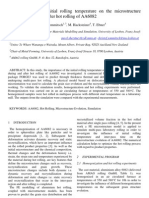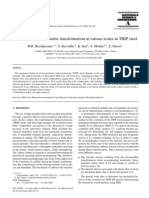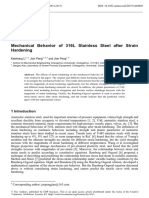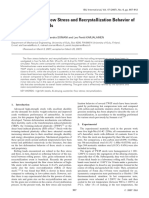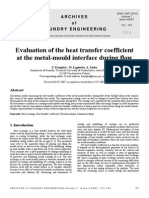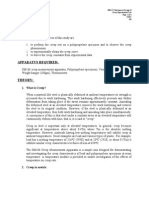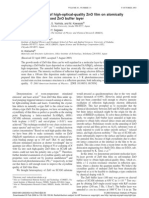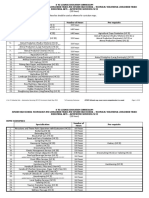Investigation On Zener-Hollomon Parameter of A Medium Carbon Low Alloy of 1Cr-1Mn-1.5Ni-1Si-0.1V Under Hot Compression Test
Investigation On Zener-Hollomon Parameter of A Medium Carbon Low Alloy of 1Cr-1Mn-1.5Ni-1Si-0.1V Under Hot Compression Test
Uploaded by
EidelsayedCopyright:
Available Formats
Investigation On Zener-Hollomon Parameter of A Medium Carbon Low Alloy of 1Cr-1Mn-1.5Ni-1Si-0.1V Under Hot Compression Test
Investigation On Zener-Hollomon Parameter of A Medium Carbon Low Alloy of 1Cr-1Mn-1.5Ni-1Si-0.1V Under Hot Compression Test
Uploaded by
EidelsayedOriginal Title
Copyright
Available Formats
Share this document
Did you find this document useful?
Is this content inappropriate?
Copyright:
Available Formats
Investigation On Zener-Hollomon Parameter of A Medium Carbon Low Alloy of 1Cr-1Mn-1.5Ni-1Si-0.1V Under Hot Compression Test
Investigation On Zener-Hollomon Parameter of A Medium Carbon Low Alloy of 1Cr-1Mn-1.5Ni-1Si-0.1V Under Hot Compression Test
Uploaded by
EidelsayedCopyright:
Available Formats
18.20.5.
2010,RoznovpodRadhostem,CzechRepublic,EU
INVESTIGATION ON ZENER-HOLLOMON PARAMETER OF A MEDIUM CARBON LOW ALLOY
OF 1Cr-1Mn-1.5Ni-1Si-0.1V UNDER HOT COMPRESSION TESt
Seyed Ali Asghar AKBARI MOUSAVI1, Majid MEISAMI2
School of Metallurgy and Materials Engineering, University Collge of Engineering, University of Tehran, Tehran,
Iran. P.O.Box: 11155-4563.
Email: 1akbarimusavi@ut.ac.ir, 2majidmeisami@yahoo.com
Abstract
The aim of this study is to investigate the hot compression behaviour of a medium carbon low alloy steel of 1Cr1Mn-1.5Ni-1Si-0.1V at temperature range of 850 to 1100
and strain rate of 0.001 to 0.5
for strain of 0.8.
The influences of the Zener-Hollomon parameters, strain and strain rate imposing on the flow stress were
analyzed in the temperature range. Deformation activation energy of the material was determined using
logarithmic, sinusoidal and hyperbolic equations. The experimental results show that the dynamic softening is
accelerated with increase of deformation temperature and decrease of strain rate. The relation between ZenerHollomon parameter Z and
found from this work is 245
1.
for studied material derived and The hot deformation activation energy
was
INTRODUCTION
Structural steels with minimum yield strength of 1380 MPa are often referred as ultra high strength steels
(UHSS)[1]. The applications of these steels are in critical cases such as pressure vessels, aircraft undercarriages,
rocket motor casings, turbine motors. In addition to their high strength to weight ratio, these steels must have
good ductility, toughness, fatigue resistance and weldability[2].
The material that used in this study is a medium carbon low alloy steel with ultra high strength that is
microalloyed with vanadium. This steel is produced by electroslag refining (ESR).
At present, no investigations on warm-hot forging process of this steel have been reported. This study
investigates hot compression behavior of this material at hot deformation temperature range and strain rate. This
study is aimed at determining the activation energy for deformation, and relations of Z, flow stress and dynamic
recrystallization.
2.
EXPERIMENTAL PROCEDURES
The chemical composition of the material is shown in Table 1. The Ar1 and Ar3 temperatures were found to be as
746
and 787 , respectively, by differential scanning calorimetry (DSC) method. Cylindrical samples of size
8mm 12mm were machined from an annealed billet. In order to determine the stress-strain behavior of the
alloy, uniaxial one-hit hot compression tests were performed on a servo-hydraulic 600KN computerized Material
Testing System (MTS, Model 8500) equipped with a resistance furnace. The deformation tests were carried out
according to the test schedule in Fig. 1. In order to minimize the friction, thin pieces of mica sheet were laid
between punch and specimen as a lubricant material.
18.20.5.2010,RoznovpodRadhostem,CzechRepublic,EU
1150
= 0 001 0 01 0 1 0 5
1100
Temperature
Table 1. Chemical composition (wt%) of studied
steel.
Component
Wt%
C
0.28 0.33
Cr
0.90 1.10
Ni
1.40 1.60
Mn
0.90 1.10
Si
0.90 1.10
0.15
Cumax
V
0.05 0.15
0.015
Pmax
0.005
Smax
Coolingrate=5
950
850
Ar3=787
Ar1 = 746
Time
Fig. 1. Schematic representation of the
thermomechanical processing conditions
3.
RESULT AND DISCUSSION
3.1.
Flow stress during hot deformation
The true stress-true strain curves of studied steel compressed at 850, 950 and 1100
at different strain rates
are shown in Fig. 2. The peak stress and peak strain of this material are shown in Table 2. True stress-true
strain curves during hot compression at various strain rates and temperatures of (a) 850
, (b) 950
, (c) 1100
18.20.5.2010,RoznovpodRadhostem,CzechRepublic,EU
(a)
(b)
(c )
(d)
Fig. 2. True stress-true strain curves during hot compression at various temperatures and strain rates of (a)
0.001
, (b) 0.01
, (c) 0.1
, 0.5
.
Table 2. Peak stress and peak strain at different temperatures and strain rates
(
0.001
0.01
0.1
0.5
T(K)
11 23
1223
1373
1123
1223
1373
1123
1223
1373
1123
1223
1373
(MPa)
0.8
0.8
0.8
0.8
0.8
0.8
0.8
0.8
0.8
0.8
0.8
0.8
306.67
142.80
82.95
330.42
217.22
97.46
477.13
326.28
157.54
476.38
316.77
269.16
18.20.5.2010,RoznovpodRadhostem,CzechRepublic,EU
(a)
(b)
(c)
Fig. 3. True stress-true strain curves during hot compression at various strain rates and temperatures of (a) 850
, (b) 950
, (c) 1100
It could be observed from Fig. 2 and Fig. 3 that the influences of temperature and strain rate on flow stress are
significant. The flow stress increases with decrease in temperature and increases in strain rate. The flow curve
typically shows work hardening region followed by dynamic softening due to recovery/recrystalization. The work
hardening is predominant at lower temperatures and higher strain rates. On the contrary, the extent of dynamic
softening is more at higher temperatures and lower strain rates. This is due to the fact that higher temperatures
and lower strain rates offer higher mobility to the grain boundary and longer time for nucleation and growth of
dynamically recrystalized grains [3].
3.2. Constitutive Equations for flow stress prediction
The correlation between the flow stress ( ), temperature ( ) and strain rate ( ), particularly at high
temperatures, could be expressed by an Arrhenius type equation[4]. Further, the effects of temperature and strain
rate on deformation behavior could be represented by Zener-Holloman Parameter (Z) in an exponent type
equation[5]. These are mathematically expressed as
Here, R is the universal gas constant (8.31
activation energy (
);
);
represents the strain rate and
is the absolute temperature in K;
,
and
is the
are material
constants. In the above equations, the Zener-Hollomon parameter Z is temperature compensated strain rate and
is the deformation activation energy.
3.3. Determination of Hot Working Constants
By taking the natural logarithm from each side of the Eqs. (1), (2) and (3), the following expressions could be
derived for peak stress:
18.20.5.2010,RoznovpodRadhostem,CzechRepublic,EU
(4)
(5)
(6)
Under the condition of constant temperature during the hot deformation process the partial differentiation of Eqs.
(4), (5) and (6) yields the following equations, respectively:
(7)
(8)
(9)
It follows from these expressions that the slope of the plot of
against
can be used for obtaining the value of
against
and the slope of the plot of
and , respectively. These plots are shown in Figures 4(a)
and (b). The linear regression of these data results in the average value of 7.4996 and 0.0289 for
. According to Eq. (9), the slope of the plot of
respectively. This gives the value of
can be used for obtaining the value of
against
and ,
(Fig. 4(c)). The average value of
was
determined as 5.39 [6].
(a)
(b)
(c)
Fig. 4. Plots used for calculation of (a) , (b) , and (c) n.
3.4. Calculation of the activation energy
The activation energy for deformation at a constant strain rate, was derived by partial differentiation of Eqs. (4),
(5) and (6) that yields the following equations, respectively:
(10)
18.20.5.2010,RoznovpodRadhostem,CzechRepublic,EU
(11)
(12)
,
It follows from these expressions that the slope of the plots of
or
versus the reciprocal of
. These plots are shown in Fig. 5. The linear
absolute temperature can be used for obtaining the value of
for activation
regression of these data results in the average value of 245, 219 and 227
energy from Eqs. (10), (11) and (12), respectively.
Fig. 5. Plots of (a)
, (b)
, and (c)
versus the reciprocal of absolute temperature.
) of these
There is a significant difference between these values. Analysis of the correlation coefficient (
regression values reveals that Eq. (10) has better fit to experimental data. Therefore, the activation energy of hot
working was considered to be 245
[6]
3.5. Peak Stress as a Function of the Zener-Hollomon Parameter
According to Eqs. (1) through (5), the plots of
relationship between
and
against
and
may be used to find the
. The corresponding curves are shown in Figure (6), and the resultant regression
equations are as follows:
(13)
(14)
(15)
Among these relations, the hyperbolic sine equation (Eq. (13)) has the highest correlation coefficient and the
power and the exponential law have good fit. In summary, the peak stress of medium carbon low alloy steel (NiCr-Mn) under deformation condition used in this study may be expressed as Eq. (16) as a result Eq. (15).
(16)
18.20.5.2010,RoznovpodRadhostem,CzechRepublic,EU
(a)
(b)
Fig. 6. Plots of
4.
(a)
, (b)
(c)
and (c)
CONCLUSIONS
Isothermal uniaxial compression tests are performed on medium carbon low alloy steel (Ni-Cr-Mn) at strain rates
of 0.001 to 0.5
1.
over a temperature range of 850 to 1100
to a strain of 0.8 and are summarized as follow:
It was shown that for correct calculation of the activation energy of hot working, one of the three
expressions of Z, namely, the power law, exponential law, and hyperbolic sin law, results in the
appropriate value. For this steel, the power law was found to be the appropriate relation, wich resulted in
the value of 245
for This steel was found.
2.
The material constant in equation of
3.
The relation between Zener-Hollomon parameter Z and
for studied material derived that is
REFERENCES
th
[1]
T. V. Philip and T. J. McCaffy: Metals handbook, 10 edn, Vol. 1; 1990, Materials Park, OH, ASM International.
[2]
S. K. Maity, N. B. Ballal, G. Goldhahn, R. Kawalla, Ironmaking and Steelmaking, 2008, Vol. 35 No3, p228-240.
[3]
S. Mandal, V. Rakesh, P.V. Sivaprasad, S. Venugopal, K.V. Kasiviswanathan, Mater. Sci. Eng. A 500 (2009) 114-121.
[4]
C. M. Sellars, W. J. MTegart, Acta Metallurgica 14 (1966) 1136-1138.
[5]
C. Zener, H. Hollomon, J. Appl. Phys. 15 (1944) 22.
[6]
H. Mirzadeh, A. Najafizadeh and M. Moazeny, Metall. Trans., 2009, Vol 40A, pp. 2950-2957.
You might also like
- Holography Research and Technologies PDFNo ratings yetHolography Research and Technologies PDF466 pages
- The Management of Gases and Thermal Quantity in The Upper Zone of Electric Furnaces in DrenasNo ratings yetThe Management of Gases and Thermal Quantity in The Upper Zone of Electric Furnaces in Drenas5 pages
- Fractography Analysis and Constitutive Modeling For Dynamic Plasticity of Austenite Stainless Steel (ASS 304) at Hot-Working TemperaturesNo ratings yetFractography Analysis and Constitutive Modeling For Dynamic Plasticity of Austenite Stainless Steel (ASS 304) at Hot-Working Temperatures33 pages
- The Effect of The Initial Rolling Temperature On The Microstructure Evolution During and After Hot Rolling of AA6082No ratings yetThe Effect of The Initial Rolling Temperature On The Microstructure Evolution During and After Hot Rolling of AA60824 pages
- 2014 - Jing - Hot Compression Behavior and Processing Map of Cast Mg-4Al-2Sn-Y-Nd AlloyNo ratings yet2014 - Jing - Hot Compression Behavior and Processing Map of Cast Mg-4Al-2Sn-Y-Nd Alloy6 pages
- 01 - A CCT Diagram For An Offshore Pipeline Steel of X70 TypeNo ratings yet01 - A CCT Diagram For An Offshore Pipeline Steel of X70 Type6 pages
- A Finite Element Analysis For The Least Temperature Rise in A Hot Torsion Test SpecimenNo ratings yetA Finite Element Analysis For The Least Temperature Rise in A Hot Torsion Test Specimen14 pages
- Modeling of The Yield Strength of A Stainless Maraging SteelNo ratings yetModeling of The Yield Strength of A Stainless Maraging Steel4 pages
- Portevin-Le Chatelier Effect in Al-Zn-Mg-Cu-Zr Aluminum AlloyNo ratings yetPortevin-Le Chatelier Effect in Al-Zn-Mg-Cu-Zr Aluminum Alloy5 pages
- Numerical Simulation On Residual Stress Distribution of Hard-Face-Welded Steel Specimens With Martensite TransformationNo ratings yetNumerical Simulation On Residual Stress Distribution of Hard-Face-Welded Steel Specimens With Martensite Transformation5 pages
- Identification of Constitutive Material Model Parameters For High-Strain Rate Metal Cutting Conditions Using Evolutionary Computational AlgorithmsNo ratings yetIdentification of Constitutive Material Model Parameters For High-Strain Rate Metal Cutting Conditions Using Evolutionary Computational Algorithms18 pages
- Effect of Strain Rate Upon Plastic Flow of SteelNo ratings yetEffect of Strain Rate Upon Plastic Flow of Steel12 pages
- Cyclic Response and Fracture Behaviors Under LCFNo ratings yetCyclic Response and Fracture Behaviors Under LCF13 pages
- Numerical Simulation of Induction Stirred LadleNo ratings yetNumerical Simulation of Induction Stirred Ladle7 pages
- Analysis of The Martensitic Transformation at Various Scales in TRIP SteelNo ratings yetAnalysis of The Martensitic Transformation at Various Scales in TRIP Steel4 pages
- Effect of Temperature On Mechanical Behavior of AZ31 Magnesium AlloyNo ratings yetEffect of Temperature On Mechanical Behavior of AZ31 Magnesium Alloy5 pages
- Mechanical Behavior of 316L Stainless Steel AfterNo ratings yetMechanical Behavior of 316L Stainless Steel After6 pages
- Grain Size Prediction in Hot Forging of A 20MnCr5 SteelNo ratings yetGrain Size Prediction in Hot Forging of A 20MnCr5 Steel27 pages
- Transient Temperature Distribution in A Steel Rod Subjected To Friction WeldingNo ratings yetTransient Temperature Distribution in A Steel Rod Subjected To Friction Welding11 pages
- Yi-Lei Li Et Al - Measurement On Effective Shear Viscosity Coefficient of Iron Under Shock Compression at 100GPaNo ratings yetYi-Lei Li Et Al - Measurement On Effective Shear Viscosity Coefficient of Iron Under Shock Compression at 100GPa3 pages
- Intermetallics: P. Hanus, E. Bartsch, M. Palm, R. Krein, K. Bauer-Partenheimer, P. JanschekNo ratings yetIntermetallics: P. Hanus, E. Bartsch, M. Palm, R. Krein, K. Bauer-Partenheimer, P. Janschek6 pages
- High-Cycle Fatigue Behavior of Type 316L Stainless SteelNo ratings yetHigh-Cycle Fatigue Behavior of Type 316L Stainless Steel9 pages
- 2007-High Temperature Flow Stress and Recrystallization Behavior of High MN TWIP SteelsNo ratings yet2007-High Temperature Flow Stress and Recrystallization Behavior of High MN TWIP Steels6 pages
- Mechanism of Mechanical Failure of Sapphire at High TemperatureNo ratings yetMechanism of Mechanical Failure of Sapphire at High Temperature10 pages
- Numerical Simulation Nugget Formation 14No ratings yetNumerical Simulation Nugget Formation 1415 pages
- Thermomechanical Processing of Pipeline Steels With A With A Reduced MN ContentNo ratings yetThermomechanical Processing of Pipeline Steels With A With A Reduced MN Content9 pages
- Mathematical Modelling of Steel QuenchingNo ratings yetMathematical Modelling of Steel Quenching6 pages
- Dynamic Strain Aging Effect On The Fatigue Resistance of Type 316L Stainless SteelNo ratings yetDynamic Strain Aging Effect On The Fatigue Resistance of Type 316L Stainless Steel5 pages
- Evaluation of The Heat Transfer Coefficient at The Metal-Mould Interface During FlowNo ratings yetEvaluation of The Heat Transfer Coefficient at The Metal-Mould Interface During Flow4 pages
- A Novel Constitutive Model For Hot Deformation Behaviors of Ti-6Al-4V Alloy Based On Probabilistic MethodNo ratings yetA Novel Constitutive Model For Hot Deformation Behaviors of Ti-6Al-4V Alloy Based On Probabilistic Method9 pages
- Mechanical Properties of High Alloyed Cast and Rolled Crmnni Trip Steels With Varying Ni ContentsNo ratings yetMechanical Properties of High Alloyed Cast and Rolled Crmnni Trip Steels With Varying Ni Contents7 pages
- Fem-Aided Experimental Determination of Fatigue Properties of Thermomechanically Processed 34crnimo6 SteelNo ratings yetFem-Aided Experimental Determination of Fatigue Properties of Thermomechanically Processed 34crnimo6 Steel4 pages
- Obect:-Apparatus Required:: Practical No.1No ratings yetObect:-Apparatus Required:: Practical No.15 pages
- Experimental Evidence For The Dynamic Jahn-Teller Effect in La Ca MnoNo ratings yetExperimental Evidence For The Dynamic Jahn-Teller Effect in La Ca Mno4 pages
- The Prediction of Maximum HAZ Hardness in Various Regions of Multiple Pass WeldsNo ratings yetThe Prediction of Maximum HAZ Hardness in Various Regions of Multiple Pass Welds10 pages
- Numerical Simulation of The Temperaturbe Filed in fixed-TIG Welding PoolNo ratings yetNumerical Simulation of The Temperaturbe Filed in fixed-TIG Welding Pool5 pages
- Temperature Dependency of Mosfet Device Characteristics in 4H-And 6H-Silicon Carbide (Sic)No ratings yetTemperature Dependency of Mosfet Device Characteristics in 4H-And 6H-Silicon Carbide (Sic)5 pages
- Reviews in Computational ChemistryFrom EverandReviews in Computational ChemistryAbby L. ParrillNo ratings yet
- Shape Memory Alloy Actuators: Design, Fabrication, and Experimental EvaluationFrom EverandShape Memory Alloy Actuators: Design, Fabrication, and Experimental EvaluationNo ratings yet
- Ceramic Materials for Energy Applications V: A Collection of Papers Presented at the 39th International Conference on Advanced Ceramics and CompositesFrom EverandCeramic Materials for Energy Applications V: A Collection of Papers Presented at the 39th International Conference on Advanced Ceramics and CompositesJosef MatyášNo ratings yet
- Heteroepitaxy of Hexagonal Zns Thin Films Directly On SiNo ratings yetHeteroepitaxy of Hexagonal Zns Thin Films Directly On Si4 pages
- Phonon Scattering of Excitons and Biexcitons in Zno: K. Hazu and T. SotaNo ratings yetPhonon Scattering of Excitons and Biexcitons in Zno: K. Hazu and T. Sota3 pages
- Brillouin Scattering Study of Zno: T. Azuhata M. Takesada and T. Yagi A. Shikanai Sf. ChichibuNo ratings yetBrillouin Scattering Study of Zno: T. Azuhata M. Takesada and T. Yagi A. Shikanai Sf. Chichibu5 pages
- Epitaxial Growth of Zno Films by Helicon-Wave-Plasma-Assisted SputteringNo ratings yetEpitaxial Growth of Zno Films by Helicon-Wave-Plasma-Assisted Sputtering4 pages
- Helicon-Wave-Excited-Plasma Sputtering Epitaxy of Zno On Sapphire 0001 SubstratesNo ratings yetHelicon-Wave-Excited-Plasma Sputtering Epitaxy of Zno On Sapphire 0001 Substrates4 pages
- Dielectric Sio / Zro Distributed Bragg Reflectors For Zno Microcavities Prepared by The Reactive Helicon-Wave-Excited-Plasma Sputtering MethodNo ratings yetDielectric Sio / Zro Distributed Bragg Reflectors For Zno Microcavities Prepared by The Reactive Helicon-Wave-Excited-Plasma Sputtering Method3 pages
- Radiative and Nonradiative Excitonic Transitions in Nonpolar 112 0 and Polar 0001 and 0001 Zno EpilayersNo ratings yetRadiative and Nonradiative Excitonic Transitions in Nonpolar 112 0 and Polar 0001 and 0001 Zno Epilayers3 pages
- RL-Series Pole Mounted Load Break Switch / SectionaliserNo ratings yetRL-Series Pole Mounted Load Break Switch / Sectionaliser12 pages
- Eu Modifies Standards For Domestic FurnitureNo ratings yetEu Modifies Standards For Domestic Furniture1 page
- Mark Scheme (Results) January 2015: Pearson Edexcel International A Level in Mechanics 2 (WME02/01)No ratings yetMark Scheme (Results) January 2015: Pearson Edexcel International A Level in Mechanics 2 (WME02/01)20 pages
- KAI UP v4.3 - KAI Node Installer Guide - v4.1.1 (Omesti Malaysia)No ratings yetKAI UP v4.3 - KAI Node Installer Guide - v4.1.1 (Omesti Malaysia)59 pages
- Unit 3, Pharmaceutical Quality Assurance, B Pharmacy 6th Sem, Carewell PharmaNo ratings yetUnit 3, Pharmaceutical Quality Assurance, B Pharmacy 6th Sem, Carewell Pharma14 pages
- Introduction To FP Dashboard (Joshua-CHAI)No ratings yetIntroduction To FP Dashboard (Joshua-CHAI)4 pages
- Cip Safety Pf527 Hott 2015 v1 - 2 Mar 18 2015100% (1)Cip Safety Pf527 Hott 2015 v1 - 2 Mar 18 201516 pages
- Concrete - Complementary British Standard To BS EN 206: BSI Standards PublicationNo ratings yetConcrete - Complementary British Standard To BS EN 206: BSI Standards Publication7 pages
- GSPN (Global Service Partner Network) : © Samsung Electronics Co.,Ltd. Jul. 2008 Printed in KoreaNo ratings yetGSPN (Global Service Partner Network) : © Samsung Electronics Co.,Ltd. Jul. 2008 Printed in Korea4 pages
- The Management of Gases and Thermal Quantity in The Upper Zone of Electric Furnaces in DrenasThe Management of Gases and Thermal Quantity in The Upper Zone of Electric Furnaces in Drenas
- Fractography Analysis and Constitutive Modeling For Dynamic Plasticity of Austenite Stainless Steel (ASS 304) at Hot-Working TemperaturesFractography Analysis and Constitutive Modeling For Dynamic Plasticity of Austenite Stainless Steel (ASS 304) at Hot-Working Temperatures
- The Effect of The Initial Rolling Temperature On The Microstructure Evolution During and After Hot Rolling of AA6082The Effect of The Initial Rolling Temperature On The Microstructure Evolution During and After Hot Rolling of AA6082
- 2014 - Jing - Hot Compression Behavior and Processing Map of Cast Mg-4Al-2Sn-Y-Nd Alloy2014 - Jing - Hot Compression Behavior and Processing Map of Cast Mg-4Al-2Sn-Y-Nd Alloy
- 01 - A CCT Diagram For An Offshore Pipeline Steel of X70 Type01 - A CCT Diagram For An Offshore Pipeline Steel of X70 Type
- A Finite Element Analysis For The Least Temperature Rise in A Hot Torsion Test SpecimenA Finite Element Analysis For The Least Temperature Rise in A Hot Torsion Test Specimen
- Modeling of The Yield Strength of A Stainless Maraging SteelModeling of The Yield Strength of A Stainless Maraging Steel
- Portevin-Le Chatelier Effect in Al-Zn-Mg-Cu-Zr Aluminum AlloyPortevin-Le Chatelier Effect in Al-Zn-Mg-Cu-Zr Aluminum Alloy
- Numerical Simulation On Residual Stress Distribution of Hard-Face-Welded Steel Specimens With Martensite TransformationNumerical Simulation On Residual Stress Distribution of Hard-Face-Welded Steel Specimens With Martensite Transformation
- Identification of Constitutive Material Model Parameters For High-Strain Rate Metal Cutting Conditions Using Evolutionary Computational AlgorithmsIdentification of Constitutive Material Model Parameters For High-Strain Rate Metal Cutting Conditions Using Evolutionary Computational Algorithms
- Analysis of The Martensitic Transformation at Various Scales in TRIP SteelAnalysis of The Martensitic Transformation at Various Scales in TRIP Steel
- Effect of Temperature On Mechanical Behavior of AZ31 Magnesium AlloyEffect of Temperature On Mechanical Behavior of AZ31 Magnesium Alloy
- Grain Size Prediction in Hot Forging of A 20MnCr5 SteelGrain Size Prediction in Hot Forging of A 20MnCr5 Steel
- Transient Temperature Distribution in A Steel Rod Subjected To Friction WeldingTransient Temperature Distribution in A Steel Rod Subjected To Friction Welding
- Yi-Lei Li Et Al - Measurement On Effective Shear Viscosity Coefficient of Iron Under Shock Compression at 100GPaYi-Lei Li Et Al - Measurement On Effective Shear Viscosity Coefficient of Iron Under Shock Compression at 100GPa
- Intermetallics: P. Hanus, E. Bartsch, M. Palm, R. Krein, K. Bauer-Partenheimer, P. JanschekIntermetallics: P. Hanus, E. Bartsch, M. Palm, R. Krein, K. Bauer-Partenheimer, P. Janschek
- High-Cycle Fatigue Behavior of Type 316L Stainless SteelHigh-Cycle Fatigue Behavior of Type 316L Stainless Steel
- 2007-High Temperature Flow Stress and Recrystallization Behavior of High MN TWIP Steels2007-High Temperature Flow Stress and Recrystallization Behavior of High MN TWIP Steels
- Mechanism of Mechanical Failure of Sapphire at High TemperatureMechanism of Mechanical Failure of Sapphire at High Temperature
- Thermomechanical Processing of Pipeline Steels With A With A Reduced MN ContentThermomechanical Processing of Pipeline Steels With A With A Reduced MN Content
- Dynamic Strain Aging Effect On The Fatigue Resistance of Type 316L Stainless SteelDynamic Strain Aging Effect On The Fatigue Resistance of Type 316L Stainless Steel
- Evaluation of The Heat Transfer Coefficient at The Metal-Mould Interface During FlowEvaluation of The Heat Transfer Coefficient at The Metal-Mould Interface During Flow
- A Novel Constitutive Model For Hot Deformation Behaviors of Ti-6Al-4V Alloy Based On Probabilistic MethodA Novel Constitutive Model For Hot Deformation Behaviors of Ti-6Al-4V Alloy Based On Probabilistic Method
- Mechanical Properties of High Alloyed Cast and Rolled Crmnni Trip Steels With Varying Ni ContentsMechanical Properties of High Alloyed Cast and Rolled Crmnni Trip Steels With Varying Ni Contents
- Fem-Aided Experimental Determination of Fatigue Properties of Thermomechanically Processed 34crnimo6 SteelFem-Aided Experimental Determination of Fatigue Properties of Thermomechanically Processed 34crnimo6 Steel
- Experimental Evidence For The Dynamic Jahn-Teller Effect in La Ca MnoExperimental Evidence For The Dynamic Jahn-Teller Effect in La Ca Mno
- The Prediction of Maximum HAZ Hardness in Various Regions of Multiple Pass WeldsThe Prediction of Maximum HAZ Hardness in Various Regions of Multiple Pass Welds
- Numerical Simulation of The Temperaturbe Filed in fixed-TIG Welding PoolNumerical Simulation of The Temperaturbe Filed in fixed-TIG Welding Pool
- Temperature Dependency of Mosfet Device Characteristics in 4H-And 6H-Silicon Carbide (Sic)Temperature Dependency of Mosfet Device Characteristics in 4H-And 6H-Silicon Carbide (Sic)
- Shape Memory Alloy Actuators: Design, Fabrication, and Experimental EvaluationFrom EverandShape Memory Alloy Actuators: Design, Fabrication, and Experimental Evaluation
- Ceramic Materials for Energy Applications V: A Collection of Papers Presented at the 39th International Conference on Advanced Ceramics and CompositesFrom EverandCeramic Materials for Energy Applications V: A Collection of Papers Presented at the 39th International Conference on Advanced Ceramics and Composites
- The Fracture of Brittle Materials: Testing and AnalysisFrom EverandThe Fracture of Brittle Materials: Testing and Analysis
- Heteroepitaxy of Hexagonal Zns Thin Films Directly On SiHeteroepitaxy of Hexagonal Zns Thin Films Directly On Si
- Phonon Scattering of Excitons and Biexcitons in Zno: K. Hazu and T. SotaPhonon Scattering of Excitons and Biexcitons in Zno: K. Hazu and T. Sota
- Brillouin Scattering Study of Zno: T. Azuhata M. Takesada and T. Yagi A. Shikanai Sf. ChichibuBrillouin Scattering Study of Zno: T. Azuhata M. Takesada and T. Yagi A. Shikanai Sf. Chichibu
- Epitaxial Growth of Zno Films by Helicon-Wave-Plasma-Assisted SputteringEpitaxial Growth of Zno Films by Helicon-Wave-Plasma-Assisted Sputtering
- Helicon-Wave-Excited-Plasma Sputtering Epitaxy of Zno On Sapphire 0001 SubstratesHelicon-Wave-Excited-Plasma Sputtering Epitaxy of Zno On Sapphire 0001 Substrates
- Dielectric Sio / Zro Distributed Bragg Reflectors For Zno Microcavities Prepared by The Reactive Helicon-Wave-Excited-Plasma Sputtering MethodDielectric Sio / Zro Distributed Bragg Reflectors For Zno Microcavities Prepared by The Reactive Helicon-Wave-Excited-Plasma Sputtering Method
- Radiative and Nonradiative Excitonic Transitions in Nonpolar 112 0 and Polar 0001 and 0001 Zno EpilayersRadiative and Nonradiative Excitonic Transitions in Nonpolar 112 0 and Polar 0001 and 0001 Zno Epilayers
- RL-Series Pole Mounted Load Break Switch / SectionaliserRL-Series Pole Mounted Load Break Switch / Sectionaliser
- Mark Scheme (Results) January 2015: Pearson Edexcel International A Level in Mechanics 2 (WME02/01)Mark Scheme (Results) January 2015: Pearson Edexcel International A Level in Mechanics 2 (WME02/01)
- KAI UP v4.3 - KAI Node Installer Guide - v4.1.1 (Omesti Malaysia)KAI UP v4.3 - KAI Node Installer Guide - v4.1.1 (Omesti Malaysia)
- Unit 3, Pharmaceutical Quality Assurance, B Pharmacy 6th Sem, Carewell PharmaUnit 3, Pharmaceutical Quality Assurance, B Pharmacy 6th Sem, Carewell Pharma
- Concrete - Complementary British Standard To BS EN 206: BSI Standards PublicationConcrete - Complementary British Standard To BS EN 206: BSI Standards Publication
- GSPN (Global Service Partner Network) : © Samsung Electronics Co.,Ltd. Jul. 2008 Printed in KoreaGSPN (Global Service Partner Network) : © Samsung Electronics Co.,Ltd. Jul. 2008 Printed in Korea






